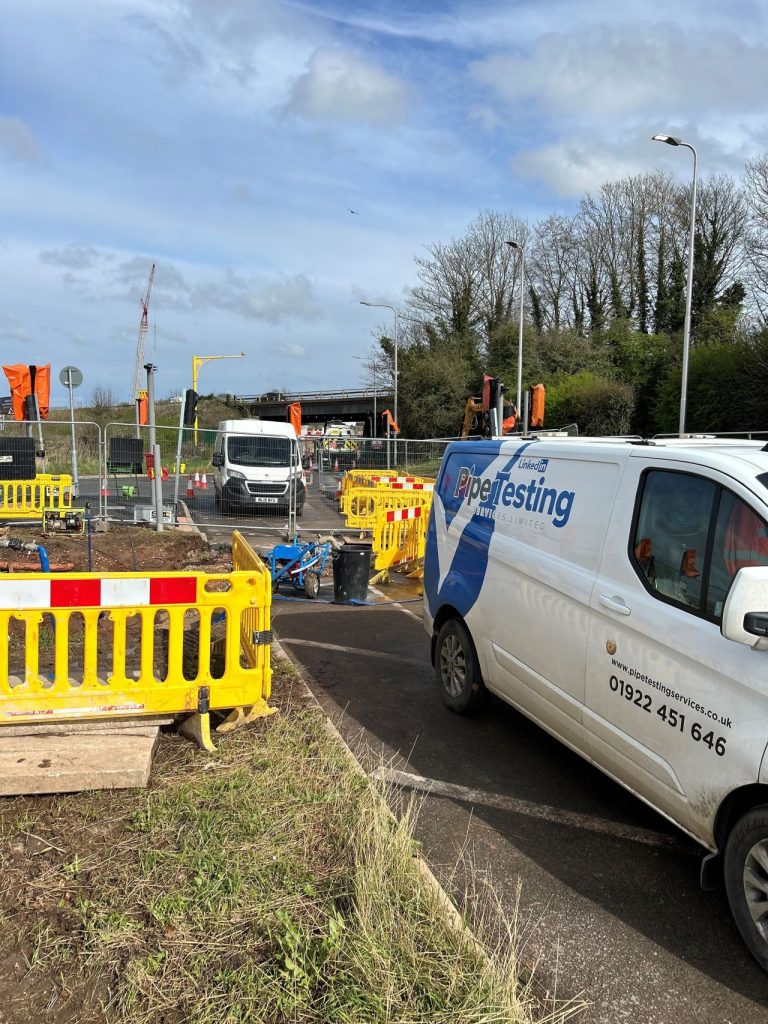Managing Dead Legs in Building Water Systems
Regarding water system safety, the presence of dead legs and blind ends poses a significant threat by creating stagnant water conditions. In turn, this fosters biofilm formation and bacterial growth, including the potentially harmful Legionella bacteria.
At Pipe Testing Services (PTS), we understand the paramount importance of identifying and effectively managing these risk areas to safeguard the health and well-being of building occupants across the UK.
Our Services
We specialise in identifying and effectively managing dead legs and blind ends in building water systems. Our team conducts comprehensive inspections, utilising advanced technologies like 3D mapping and thermal imaging to pinpoint these risk areas accurately.
We develop tailored flushing regimes and implement stringent protocols to mitigate the risks associated with stagnant water, biofilm formation, and Legionella growth. Our services also include conducting thorough Legionella risk assessments and providing guidance on water system documentation and record-keeping.
In addition to dead leg management, PTS offers a wide range of services to ensure water system safety and compliance, including legionella remedial works, guidance on legionella compliance audits, and chlorination services customised to your facility, or water systems, needs.
Partner with our experienced professionals to safeguard your water systems, mitigate risks, and maintain regulatory compliance. Contact us today to discuss your requirements and schedule a consultation.
Understanding the Risks of Dead Legs and Blind Ends
What is a Dead Leg?
A dead leg is a section of pipework that leads to a fitting through which water passes infrequently, typically when there is a draw-off or outlet usage. These areas of low or no water circulation allow stagnation, enabling biofilms to thrive and increasing the legionella risk. Blind ends, which are closed sections of pipework with no water flow, further exacerbate this problem by creating pockets of stagnant water.
The consequences of unmanaged dead legs and blind ends extend beyond the potential for Legionella growth. Stagnant water and biofilm accumulation can accelerate pipe corrosion, particularly in scenarios where biofilms trap water against pipe surfaces, a phenomenon known as under-deposit corrosion. This degradation not only compromises the integrity of the plumbing system but can also introduce heavy metals and other contaminants into the water supply, posing additional health risks.
Proactive Strategies for Identifying and Managing Dead Legs
Effective dead leg management requires a comprehensive approach that encompasses regular inspections, flushing regimes, risk assessments, and meticulous documentation.
At PTS, our experts implement industry-leading practices to ensure the safety and compliance of water systems across diverse sectors.
How We Handle Dead Leg Management
Inspection and Mapping
Regular inspections are crucial for identifying and mapping dead legs and blind ends within a building’s water system. Our team utilises cutting-edge technologies, such as 3D mapping and thermal imaging, to pinpoint potential problem areas accurately.
This process involves thoroughly examining water system schematics and as-fitted drawings, as well as conducting on-site inspections to verify the presence and locations of dead legs.
Flushing Regimes
Once identified, a stringent flushing regime is established to ensure that stagnant water is regularly expelled from dead legs and blind ends, minimising the risk of bacterial growth and biofilm formation.
These flushing routines are tailored to the specific requirements of each water system, taking into account factors such as pipe diameters, water demand patterns, and the frequency of use for various outlets.
Legionella Risk Assessments
A comprehensive Legionella risk assessment is a fundamental step in understanding the unique vulnerabilities posed by dead legs within a specific water system. Our experienced professionals conduct thorough evaluations, analysing factors such as water system design, usage patterns Additionally, maintenance practices, and the presence of potential risk areas.
Based on the assessment findings, tailored control measures and monitoring protocols are recommended. These efforts mitigate the risks associated with dead legs. As well as blind ends, and other potential sources of Legionella contamination.
If you’re interested in our legionella services, take a look at the drop-down menu above for more information on the services we provide as expert legionella contractors in the UK. We operate nationwide, so don’t hesitate to get in conduct and discuss your details
Detailed Documentation and Record-Keeping
Maintaining accurate and up-to-date records is essential for demonstrating compliance and tracking the effectiveness of dead leg management strategies. Our team meticulously documents water system schematics, as-fitted drawings, commissioning data, flushing routines, and water safety records specific to dead legs and blind ends. This information serves as a valuable resource for ongoing maintenance, audits, and future system modifications or expansions.

Industry-Specific Challenges and Solutions for Dead Leg Management
While the principles of dead leg management remain consistent across sectors, different types of buildings and industries may face unique challenges.
At PTS, we tailor our approach to address the specific needs of each client, drawing upon our extensive experience in various environments. Let’s take a look at how we can help different industries:
Healthcare Facilities
In healthcare settings, such as hospitals and care homes, the risk of Legionella exposure is heightened due to the presence of vulnerable populations. Our team works closely with facility managers to implement rigorous dead leg and blind end management protocols, including frequent flushing of seldom-used outlets, continuous monitoring, and strict adherence to industry-specific regulations.
Educational Institutions
Schools and universities often have complex water systems with numerous outlets that may be infrequently used during holidays or breaks, increasing the risk of stagnation in dead legs and blind ends. Our experts develop customised flushing schedules and conduct regular risk assessments to ensure the safety of students and staff upon their return.
Hospitality and Leisure Facilities
Hotels, resorts, and leisure facilities frequently experience fluctuations in water usage, making dead leg and blind end management a critical concern. We work hand-in-hand with facility operators to design efficient flushing routines, implement temperature control measures, and provide ongoing support to maintain water system integrity and mitigate the risks associated with stagnant water.
Industrial and Commercial Premises
In industrial and commercial settings, water systems may be subject to significant variations in demand, increasing the risk of stagnation in dead legs and blind ends. Our team collaborates with clients to optimise system design, implement effective flushing protocols, and conduct regular inspections to mitigate the risks associated with these problem areas.
Dead Legs - FAQs
How can I identify dead legs in my building's water system?
Identifying dead legs and blind ends typically involves a thorough inspection of your water system’s schematics, as-fitted drawings, and on-site assessments. At PTS, we use advanced technologies like 3D mapping and thermal imaging to pinpoint these risk areas accurately.
What are the risks associated with stagnant water in dead legs?
Stagnant water in dead legs and blind ends can lead to biofilm formation, legionella growth, and increased corrosion risks, particularly under-deposit corrosion. These conditions can compromise water quality and pose health hazards.
How often should I flush dead legs in my water system?
The frequency of flushing depends on various factors, such as pipe diameters, water demand patterns, and the risk level associated with your facility. Our experts develop tailored flushing regimes based on a comprehensive assessment of your water system.
Is a legionella risk assessment necessary for managing dead legs?
Yes, a legionella risk assessment is crucial for understanding the specific risks posed by dead legs and blind ends in your water system. This assessment helps identify control measures and monitoring protocols to mitigate these risks effectively.
What documentation is required for dead leg management?
Maintaining accurate water safety records, commissioning data, as-fitted drawings, and flushing logs is essential for demonstrating compliance and tracking the effectiveness of your dead leg management strategies.
Partnering with Pipe Testing Services for Water System Safety
At Pipe Testing Services, we are committed to providing comprehensive solutions for water system safety and Legionella control. Our team of experts combines in-depth knowledge, cutting-edge technologies, and a dedication to delivering tailored solutions that meet the unique needs of each client.
By partnering with PTS, you can rest assured that your water systems are in capable hands. We prioritise proactive measures, documentation, and regulatory compliance, ensuring the well-being of building occupants and mitigating the risks associated with dead legs, blind ends, and Legionella growth.
Phone – 01922 451646
Email – enquiries@pipetestingservices.co.uk
Address – Unit 27 Birchbrook Industrial Estate, Shenstone, Lichfield, Staffs, WS14 0DJ
Don’t compromise on water system safety. Contact Pipe Testing Services today to schedule a consultation and take the first step towards a safer, healthier environment for all.

